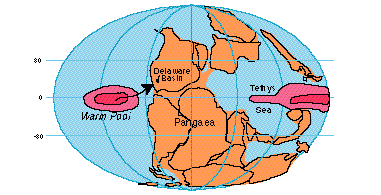
As all artists know, materials make the difference. When we looked closely, and wondered how they had formed, understanding the patterns became a challenge. My student, Douglas Kirkland, noticed immediately that it was the thinnest layers that were the most crumpled - an important clue. The thickest layers had put up more resiostance and had folded only a little. His measurements showed that the thickest layers just got fatter. There was only one way this could be explained. The rock had been squuezed sideways and each layer responded in its own way to being squuezed.

From the direction of folding Kirkland deduced that
the layers were compressed by forces within the earth's crust at a time
when the Pacific oceanic plate collided and slipped under the North American
plate, 40 to 50 million years ago. This meant that the patterns formed when
the material was already rock, almost 200 million years after the layers
were laid down on the seafloor as a gooey mud.

Back then, when the mud was still soft, the Delaware Basin lay just east of the warm waters of the ancestral Pacific. Each year in the warm season, clouds drifted eastward from the warm pool, watering the basin, and a dark layer rich with algae was produced. And each year, as the skies cleared and the sun burned down, water evaporated and made a light layer.